Maintaining a reliable and communicative team is crucial for business success. One of the most disruptive issues that employers face is the “no call no show” scenario. A no call no show occurs when an employee fails to report to work without notifying their employer. Understanding the no call no show explanation is essential for both employers and employees, as it impacts productivity, team morale, and overall workplace efficiency. In this article, we will delve into the reasons behind no call no show incidents, their consequences, samples of no call no show write ups, and effective strategies to prevent and manage them.
What Is a No Call No Show
A no call no show is a workplace term used to describe a situation where an employee does not report to work and fails to inform their employer of their absence. This behavior disrupts the workflow and can cause significant operational challenges for businesses.
Legally, a no show at work is generally defined as an unapproved absence where an employee neither attends their scheduled work shift nor notifies their employer about their inability to work.
The specifics can vary by jurisdiction and company policy, but this term typically implies a breach of contract or company attendance policy.
In many employment contracts, a no call no show can be considered job abandonment if it occurs over a specified number of consecutive days, often three. This means the employer may have grounds to terminate the employee for failing to communicate their absence, as it indicates a lack of intent to return to work.
Causes and Consequences of No Call No Show
No call no show incidents can stem from a variety of causes, each with its own set of underlying issues and complexities. Understanding these causes is essential for both employers and employees to mitigate such situations effectively.
Common causes of no call no show
One of the most frequent causes of no call no show is personal emergencies. These can include sudden health problems, family crises, or accidents that leave the employee unable to notify their employer in time. In such cases, the employee’s primary focus is often on dealing with the immediate emergency, resulting in unintentional absenteeism without prior notice.
- Personal emergencies: Sudden health problems, family crises, or accidents can prevent an employee from notifying their employer.
- Miscommunication: Misunderstandings about work schedules or absence reporting procedures can lead to no call no show incidents.
- Job dissatisfaction: Employees feeling unproductive, undervalued, or unhappy with their work environment may stop showing up as a form of silent protest.
- Lack of responsibility: Some employees may not understand the importance of notifying their employer about an absence.
- Mental health issues: Conditions such as stress, anxiety, and depression can impede an employee’s ability to manage responsibilities, including reporting absences.

Consequences of no call no show
The repercussions of no call no show incidents extend beyond the individual employee to affect the entire organization and team dynamics.
- Operational disruption: Unplanned absences can lead to workflow interruptions and increased workloads for other employees.
- Erosion of trust: Repeated no call no show incidents undermine the employer’s confidence in the employee’s reliability.
- Disciplinary actions: Employers may issue formal warnings, suspensions, or even terminate employment in response to persistent no call no show behavior.
- Impact on team morale: Colleagues may experience frustration and increased stress when covering for an absent employee without prior notice.
Employers typically have policies in place to address no call no show situations, often including disciplinary actions. Depending on the severity and frequency of the incidents, consequences can range from formal warnings and suspension to termination of employment. In some cases, persistent no call no show behavior can be classified as job abandonment, which has its own set of legal implications, including the potential loss of unemployment benefits.
Furthermore, the impact on team morale should not be underestimated. When other employees have to cover for an absent colleague without prior notice, it can lead to frustration, increased stress, and decreased overall job satisfaction. This strain on team dynamics can result in a less cohesive and motivated workforce.
How to Handle No Call No Show Incidents
Effectively managing no call no show incidents is crucial for maintaining productivity, morale, and a positive work environment. Here’s a comprehensive guide on how to handle these situations proactively and constructively.
Establish clear policies
The first step in managing no call no show incidents is to establish clear and comprehensive attendance policies. These policies should be outlined in the employee handbook and communicated to all employees during their onboarding process.
- Define expectations: Clearly articulate what constitutes a no call no show and the expected protocol for notifying absences.
- Specify consequences: Outline the disciplinary actions that will be taken in response to no call no show incidents, ranging from verbal warnings to potential termination.
- Provide examples: Include examples of acceptable and unacceptable absence notifications to eliminate any ambiguity.
Foster a supportive work environment
Creating a supportive work environment can reduce the frequency of no call no show incidents. Employees are more likely to communicate openly about their absences if they feel valued and supported.
- Open communication: Encourage a culture of open communication where employees feel comfortable discussing personal or professional issues that may affect their attendance.
- Employee assistance programs (EAPs): Offer EAPs to provide support for employees dealing with personal or mental health issues.
- Regular check-ins: Managers should conduct regular check-ins with their team members to address any concerns or challenges they may be facing.

Implement reliable communication channels
Ensuring that employees have reliable and easy-to-use communication channels is essential for reducing no call no show incidents. Provide multiple ways for employees to report absences.
- Multiple channels: Allow employees to notify absences via phone calls, emails, or dedicated absence-reporting apps.
- 24/7 availability: Ensure that the communication channels are available 24/7 to accommodate emergencies that occur outside of regular working hours.
- Automated responses: Implement automated responses to acknowledge receipt of absence notifications, providing peace of mind to employees.
Address incidents promptly
When a no call no show incident occurs, it’s important to address it promptly and professionally. Delaying the response can lead to further misunderstandings and operational disruptions.
- Immediate follow-up: Contact the employee as soon as possible to check on their well-being and understand the reason for their absence.
- Documentation: Record the details of the incident, including the date, time, and any communication attempts made.
- Assessment: Evaluate whether the absence was justified or if it was a breach of company policy.
Conduct a return-to-work interview
Conducting a return-to-work interview after a no call no show incident provides an opportunity to discuss the situation with the employee and prevent future occurrences.
- Understand the reason: Give the employee a chance to explain their absence and any extenuating circumstances.
- Reiterate policies: Review the attendance policy with the employee and clarify expectations for future notifications.
- Offer support: If the employee is facing personal or professional challenges, offer resources or adjustments to help them manage their responsibilities.
Apply disciplinary actions consistently
Consistency in applying disciplinary actions ensures fairness and reinforces the importance of the attendance policy.
- Follow protocol: Adhere to the disciplinary procedures outlined in the attendance policy, whether it’s a verbal warning, written warning for a no call no show write up, or suspension.
- Document actions: Keep detailed records of all disciplinary actions taken, including the employee’s response and any follow-up actions required.
- Provide feedback: Constructive feedback can help employees understand the impact of their actions and encourage improvement.
Utilize a time clock app
To effectively monitor employee attendance and reduce no call no show incidents, implementing a time tracker or time clock app is essential. Everhour is a highly recommended solution for this purpose.
- Accurate time tracking: Everhour allows for precise tracking of work hours, ensuring that attendance records are accurate and up-to-date.
- Automated reports: Generate detailed reports on employee attendance, making it easier to identify patterns and address issues promptly.
- Seamless integration: Everhour integrates with various project management tools, streamlining workflows and enhancing productivity.
- Real-time monitoring: Monitor employee attendance in real time, enabling managers to address no call no show incidents as they occur.
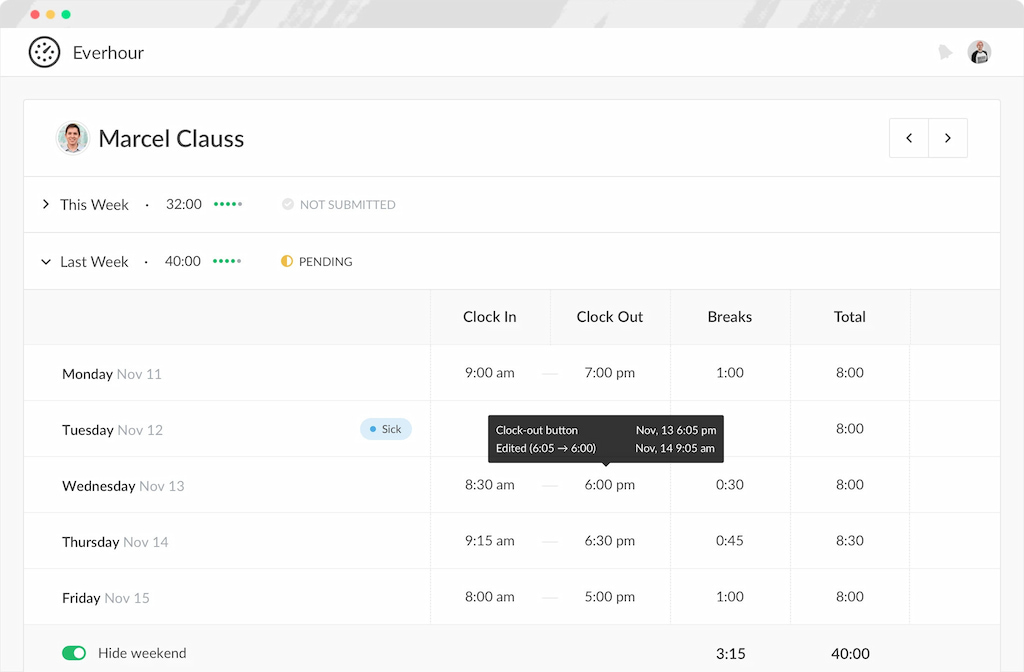
By incorporating a reliable time tracking tool like Everhour, you can maintain accurate attendance records, identify potential issues early, and ensure that your team remains accountable and productive.
Review and improve policies
Regularly reviewing and updating your attendance policies can help address new challenges and improve their effectiveness.
- Solicit feedback: Gather feedback from employees and managers about the current attendance policy and its implementation.
- Analyze trends: Look for patterns in no call no show incidents to identify potential areas for improvement in your policies or communication practices.
- Policy updates: Update the attendance policy as needed to reflect any changes in company practices or legal requirements.
By taking these steps, employers can manage no call no show incidents effectively, minimizing their impact on the organization and fostering a more reliable and communicative workplace.
Why Use a No Call No Show Policy & How to Create It
Importance of a no call no show policy
A no call no show policy is crucial for maintaining operational efficiency, ensuring accountability, and fostering a positive work environment. Here’s why implementing such a policy is beneficial:
- Operational efficiency: unplanned absences without notification can disrupt workflow, delay projects, and overburden other employees. A clear policy ensures that all team members understand the importance of attendance and the impact of unexpected absences.
- Employee accountability: a no call no show policy holds employees accountable for their attendance and reinforces the expectation that they communicate any issues promptly. This fosters a sense of responsibility and professionalism.
- Consistent standards: having a standardized policy ensures that all employees are treated equally and fairly. It removes ambiguity and ensures that everyone knows the procedures and consequences related to unreported absences.
- Improved morale: consistent enforcement of attendance policies helps prevent resentment among employees who regularly show up on time. It shows that the company values punctuality and reliability.
- Legal protection: a well-documented no call no show policy provides legal protection for the company. It ensures compliance with labor laws and offers a clear framework for handling attendance-related disputes.
How to create a no call no show policy
Creating an effective no call no show policy involves several key steps to ensure it is clear, comprehensive, and enforceable. Here’s how to develop a policy that works for your organization:
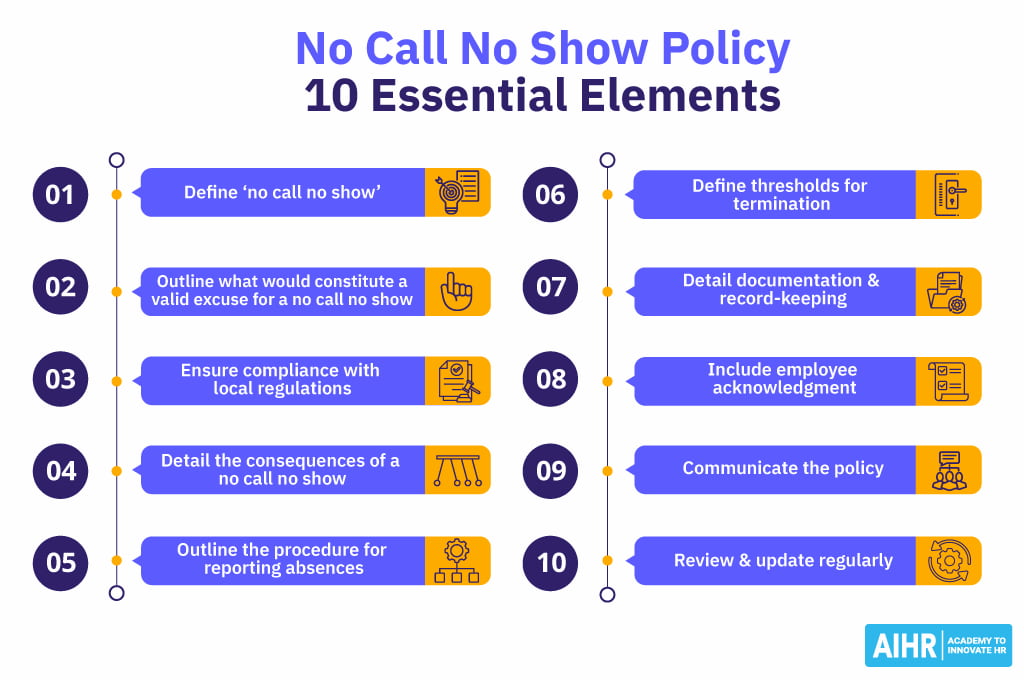
1️⃣ Define no call no show
- Clear definition: start by providing a clear definition of what constitutes a no call no show. Specify the timeframe within which an employee must notify their absence (e.g., before their shift starts).
- Examples: include examples to illustrate what is and isn’t acceptable. For instance, failing to notify a manager or HR within the specified timeframe without a valid reason would be considered a no call no show.
2️⃣ Outline notification procedures
- Multiple channels: specify the acceptable methods for notifying absences, such as phone calls, emails, or using an absence-reporting app. Provide contact details and emphasize the importance of timely communication.
- Emergency procedures: outline the steps employees should take in case of emergencies that prevent them from following the standard notification procedure.
3️⃣ Specify consequences
- Disciplinary actions: clearly outline the disciplinary actions that will be taken for no call no show incidents. This may include verbal warnings, written warnings, suspension, or termination, depending on the severity and frequency of the incidents.
- Progressive discipline: implement a progressive discipline approach, where the severity of consequences increases with repeated offenses. This allows employees to correct their behavior.
4️⃣ Include support resources
- Employee assistance programs (EAPs): mention any available support programs that can help employees deal with personal or professional issues that may affect their attendance.
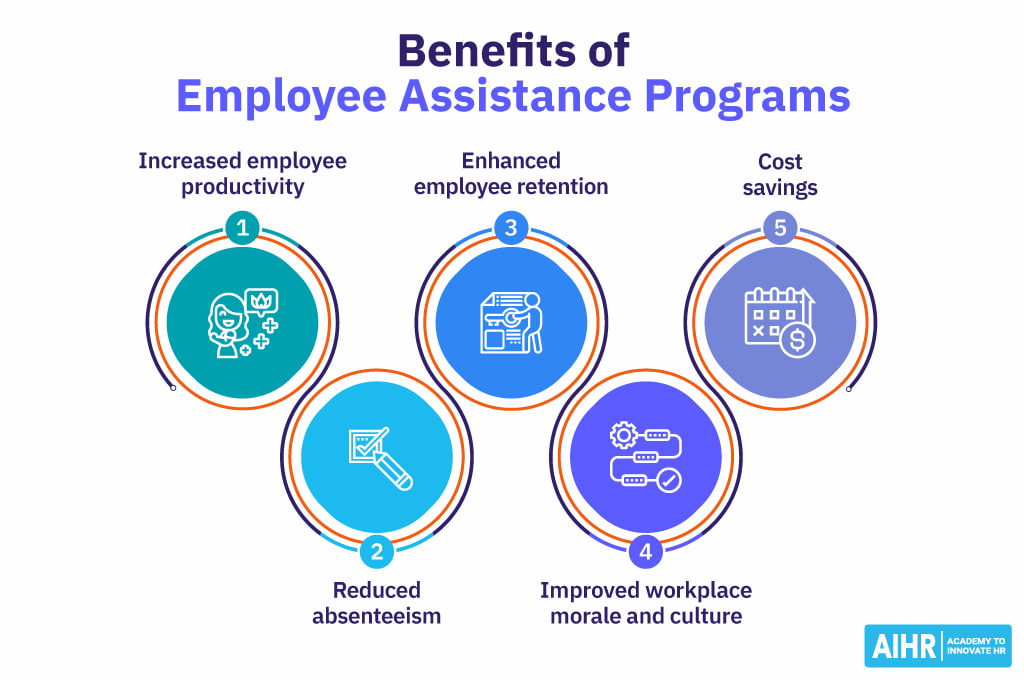
- Open communication: encourage employees to communicate openly about any challenges they face that may lead to attendance issues. Provide contact information for HR or designated support personnel.
5️⃣ Document and communicate the policy
- Employee handbook: include the no call no show policy in the employee handbook. Ensure that all employees have access to it and understand its contents.
- Onboarding process: review the policy with new hires during their onboarding process to ensure they are aware of the expectations and procedures from the start.
- Regular reminders: periodically remind employees about the policy and any updates to ensure ongoing awareness and compliance.
6️⃣ Implement and enforce consistently
- Training for managers: train managers and supervisors on how to enforce the policy consistently and fairly. Ensure they understand the importance of documentation and timely intervention.
- Consistent application: apply the policy consistently across all employees to avoid any perception of favoritism or discrimination. Consistent enforcement reinforces the policy’s importance and effectiveness.
7️⃣ Review and update regularly
- Periodic review: regularly review the policy to ensure it remains relevant and effective. Update it as needed to address any new challenges or changes in labor laws.
- Solicit feedback: gather feedback from employees and managers to identify any areas for improvement. Use this feedback to refine the policy and its implementation.
Examples of No Call No Show Policies
Here are several employee no call no show policies for several industries that you can use or base your own policy on.
Example 1: Retail industry
Policy Title: No Call No Show Policy
Policy Statement: Employees must notify their supervisor or the store manager at least 2 hours before their scheduled shift if they are unable to attend work. Failure to notify will be considered a no call no show.
Consequences:
- First Incident: Verbal warning and counseling session.
- Second Incident: Written warning and suspension without pay for one shift.
- Third Incident: Final written warning and suspension for three shifts.
- Fourth Incident: Termination of employment.
Notification Procedure:
- Call the store manager directly at [Phone Number].
- Send a text message to the store manager’s mobile number.
- Use the designated store call-in line at [Call-in Number].
Support Resources:
- Employee Assistance Program (EAP) available at [Contact Information].
- HR support for personal or family emergencies.
Example 2: Office environment
Policy Title: Attendance and No Call No Show Policy
Policy Statement: Employees must notify their supervisor or HR department at least 1 hour before their scheduled start time if they are unable to come to work. Failure to notify will be considered a no call no show.
Consequences:
- First Incident: Written warning and mandatory meeting with HR.
- Second Incident: Final written warning and suspension for 1 day.
- Third Incident: Termination of employment.
Notification Procedure:
- Call or text the HR department at [HR Phone Number].
- Email HR at [HR Email Address].
Support Resources:
- EAP services available at [Contact Information].
- Confidential counseling services for personal issues.
Example 3: Healthcare facility
Policy Title: No Call No Show Policy for Healthcare Staff
Policy Statement: Healthcare staff are required to notify their supervisor or the HR department at least 4 hours before their shift if they are unable to work. Failure to comply will be considered a no call no show.
Consequences:
- First Incident: Written warning and mandatory counseling session with HR.
- Second Incident: Suspension without pay for 2 shifts.
- Third Incident: Final warning and suspension for 5 shifts.
- Fourth Incident: Termination of employment.
Notification Procedure:
- Call the supervisor directly at [Supervisor Phone Number].
- Use the designated hospital call-in system at [Call-in Number].
- Email HR at [HR Email Address].
Support Resources:
- Access to EAP services at [Contact Information].
- Onsite support from the staff wellness program.
How to Write a No Call No Show Termination Letter
When terminating an employee for a no call no show incident, it’s crucial to handle the situation with professionalism and clarity. A well-written termination letter not only communicates the decision but also ensures legal compliance and fairness. Here are key steps to consider when drafting a write up for no call no show:
Header and salutation
- Begin with the company letterhead, including the company name, address, and contact information.
- Address the no call no show warning letter to the employee using their full name and title (if applicable). Use a respectful salutation such as “Dear [Employee’s Name].”
Introduction
- Clearly state the purpose of the letter right away. Begin with a straightforward statement such as “This letter serves as formal notification of your termination from [Company Name] due to a no call no show incident.”
Details of the incident
- Provide a brief overview of the specific incident(s) of no call no show. Include dates, times, and any relevant details that demonstrate the employee’s absence without notification.
Company policies and expectations
- Reference the company’s attendance policy and highlight how the employee’s actions violated these policies. Be specific about the expectations regarding attendance, notification procedures, and consequences for failing to adhere to these policies.
Termination decision
- Clearly state the decision to terminate the employee’s employment due to the no call no show incident. Use firm but respectful language to convey this decision.
Next steps and final instructions
- Provide information on any final payments, benefits, or severance packages the employee is entitled to, based on company policy and local laws.
- Include instructions for returning company property, if applicable, and details on the exit process.
Contact information
- Offer contact information for HR or a designated representative whom the employee can reach out to with any questions regarding the termination process.
Closing
- End the letter on a professional note, expressing well wishes for the employee’s future endeavors. Use a closing such as “Sincerely” or “Best regards.”
Signature
- Sign the disciplinary no call no show write up personally or include the signature of the appropriate company representative (e.g., HR manager, supervisor) along with their printed name and title.
Legal review
- Before finalizing the letter, ensure it complies with local employment laws and regulations. If necessary, have the letter reviewed by legal counsel to mitigate any potential legal risks.
Strategies for Prevention of No Call No Show
No call no show incidents, where employees fail to notify or attend work without explanation, can disrupt workflow and impact team morale. To mitigate these challenges, organizations can implement proactive strategies aimed at encouraging accountability, open communication, and flexibility. Below are effective strategies that businesses can adopt to prevent no call no show occurrences and promote a culture of reliability and responsibility among employees.
📜 Clear attendance policies
Establish and communicate clear attendance policies outlining expectations for attendance, punctuality, and notification procedures for absences. Ensure all employees are aware of these policies during onboarding and through regular reminders.
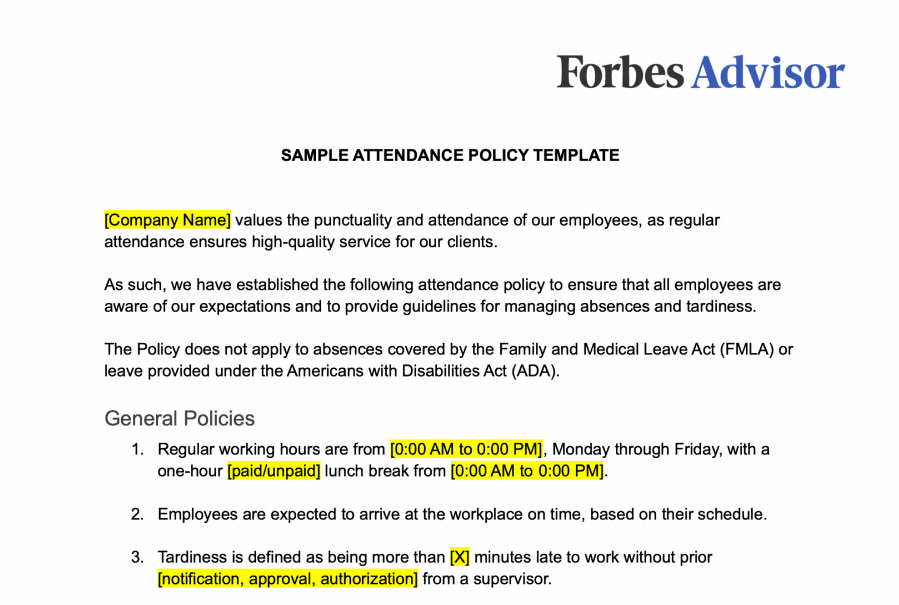
💪 Employee training
Provide training sessions or materials that emphasize the importance of attendance and the consequences of no call no show incidents. Educate employees on how their attendance impacts team dynamics and productivity.
🗣️ Encourage open communication
Foster an environment where employees feel comfortable communicating about potential scheduling conflicts or unexpected circumstances that may prevent them from coming to work. Encourage them to notify supervisors or HR as soon as possible.
📆 Flexible scheduling options
Offer flexible scheduling options such as remote work, adjusted hours, or compressed workweeks to accommodate employees’ personal needs or unforeseen situations that may arise.
Implement attendance tracking tools
Use time tracking and attendance tracker software like Everhour to monitor employee attendance and absenteeism patterns. These tools can help identify trends and address potential issues proactively.
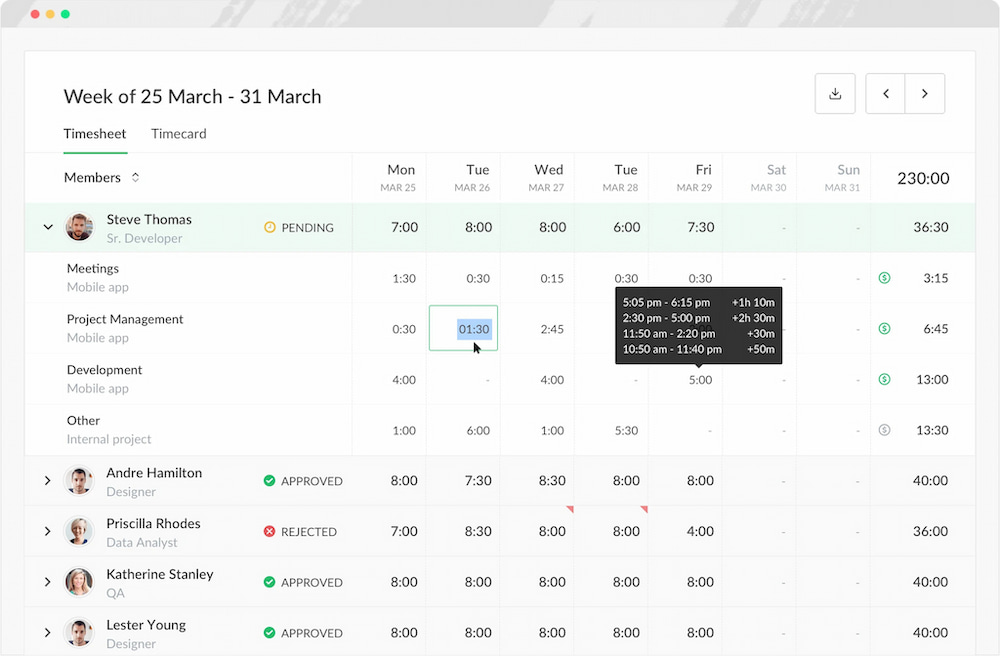
Regular feedback and check-ins
Conduct regular performance reviews and check-ins to discuss attendance expectations and address any concerns or challenges employees may be facing that could impact their attendance.
Incentives for good attendance
Implement an incentive program for employees with excellent attendance records. Positive reinforcement can motivate employees to prioritize attendance and punctuality.
Address attendance issues promptly
Address attendance issues promptly and consistently. Provide constructive feedback and support to employees who struggle with attendance to help them improve and understand the importance of reliability.
Employee assistance programs (EAPs)
Offer access to EAPs or other resources that provide support for personal or family issues that may affect attendance. Ensure employees are aware of these resources and feel comfortable utilizing them.
Promote work-life balance
Encourage work-life balance initiatives that support employees’ well-being and reduce burnout, which can contribute to absenteeism. Flexible leave policies and wellness programs can help employees manage their personal and professional responsibilities effectively.
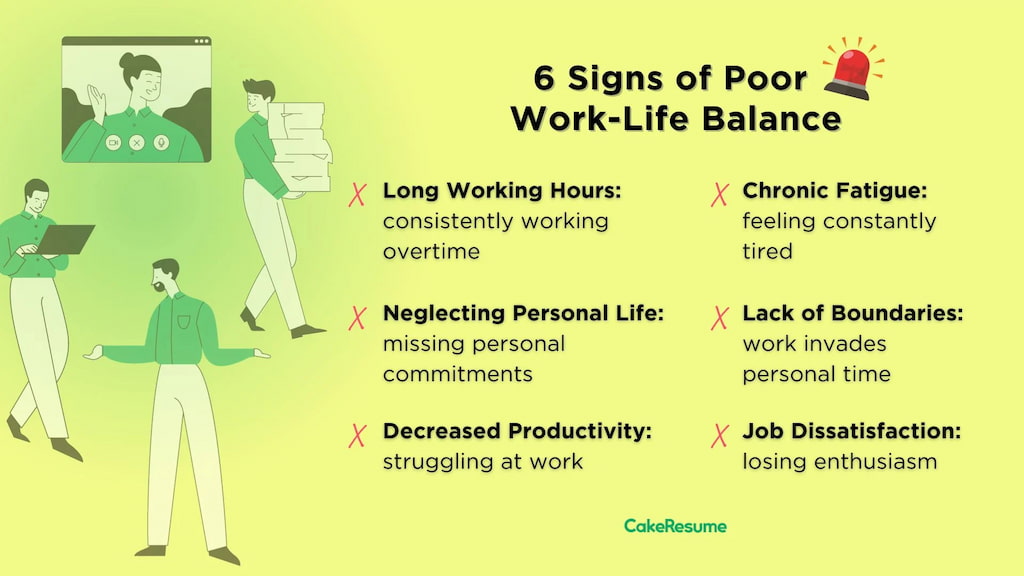
Leveraging Everhour to Prevent No Call No Show Incidents
In conclusion, managing and reducing no call no show incidents is essential for maintaining workplace efficiency and morale. By implementing clear policies, fostering open communication, and utilizing effective tools like Everhour, businesses can significantly mitigate the risks associated with absenteeism. Everhour’s robust time tracking and management features enable supervisors to monitor attendance, track project timelines, and identify potential issues early on. This proactive approach not only helps in addressing attendance issues promptly but also promotes a culture of accountability and transparency within the team.
By integrating Everhour into daily operations, organizations can streamline their workflow, enhance productivity, and ultimately foster a more reliable and engaged workforce.
Find out how to reduce no-shows with real-time shift updates →

